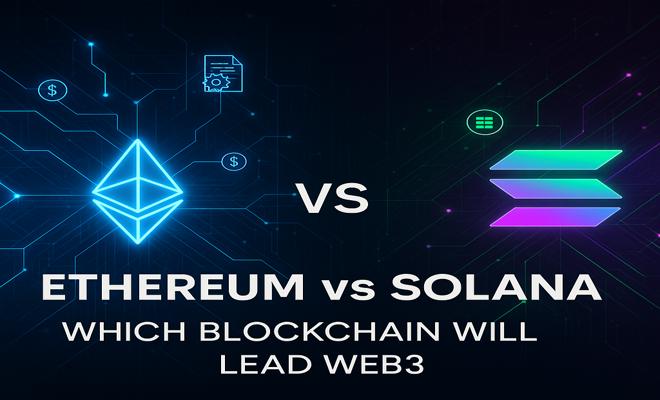
Ethereum vs Solana: Which Blockchain Will Lead Web3 in the Future?
The battle for Web3 dominance is heating up. Two of the most prominent contenders, Ethereum and Solana, are taking very different approaches to becoming the infrastructure layer for decentralized applications. But which one is truly built to power the future of Web3?
🔍 Introduction to Web3
Web3 represents the decentralized internet powered by blockchain technologies. Unlike Web2, which relies on centralized servers, Web3 applications (dApps) are open, trustless, and permissionless. Choosing the right blockchain foundation is critical for developers and users alike.
⚔️ Overview: Ethereum vs Solana
| Feature | Ethereum | Solana |
|---|---|---|
| Consensus Mechanism | Proof-of-Stake (Ethereum 2.0) | Proof-of-History + Proof-of-Stake |
| Transactions Per Second (TPS) | 30–100 (Layer 1) | 65,000+ |
| Average Fees | $1–$50 (depending on congestion) | ~$0.00025 |
| Developer Ecosystem | Largest in crypto | Rapidly growing |
| Smart Contract Language | Solidity | Rust & C |
| Uptime History | Very stable | Frequent outages (in past) |
⚡ Speed & Scalability
Solana is known for its blazing-fast performance — processing over 65,000 transactions per second. Ethereum, while slower, is catching up via Layer 2 solutions like Arbitrum and Optimism, which offload activity from the main chain and reduce congestion.

💰 Transaction Fees
Ethereum’s gas fees can spike dramatically during peak usage, making small transactions expensive. Solana offers extremely low transaction costs, which is great for micro-payments and mass adoption — a clear advantage in many use cases.
🌍 Decentralization vs Efficiency
Ethereum prioritizes decentralization and security over speed. It’s more distributed and has over 10,000 active nodes globally. Solana sacrifices some decentralization for performance, relying on fewer nodes and a more centralized validator set.
👨💻 Developer Ecosystem
Ethereum dominates in terms of developer tools, documentation, and community. It powers most of the top DeFi and NFT apps. Solana, while newer, is rapidly attracting developers thanks to its scalability and performance.
🏗️ Ecosystem & dApp Adoption
- Ethereum: Home to Uniswap, Aave, OpenSea, and MakerDAO
- Solana: Hosts Phantom Wallet, Magic Eden, and Serum
Ethereum has the first-mover advantage, but Solana's dApp ecosystem is expanding quickly, especially in NFTs and gaming.
📉 Total Value Locked (TVL) Comparison
As of early 2025:
- Ethereum TVL: $45B+
- Solana TVL: ~$3.5B
While Ethereum still holds the lead in DeFi capital, Solana is seeing strong year-over-year growth.
📈 Developer Growth Trends

According to Electric Capital, Solana has the fastest-growing developer base among all blockchains, though Ethereum still has the most total developers by a large margin.
🔮 Which Blockchain Will Lead Web3?
There’s no one-size-fits-all answer. Ethereum is the safe, decentralized choice with a massive community. Solana offers superior performance and a better user experience — at the cost of occasional stability issues.
✅ If you’re building for high-security financial apps: Ethereum is still king. ✅ If you want low-cost and high-speed UX: Solana is the top pick.
🏁 Conclusion
In the end, the Web3 future may not be winner-takes-all. A multi-chain ecosystem is emerging, where Ethereum and Solana co-exist and complement each other. Your choice depends on your project's needs and your belief in decentralization vs speed.
Stay updated on the Web3 race with BitMedia24 — your trusted source for crypto insights! 🌐